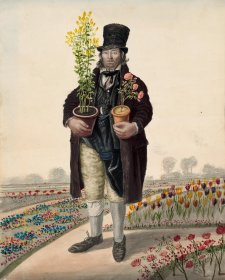Although the inscription identifies this young man as a ‘policeman’, the work’s probable date of 1825 places it some years before Sir Robert Peel’s 1829 Bill for Improving the Police in and near the Metropolis, which is commonly regarded as marking the beginning of Britain’s modern criminal justice system. The subject of this watercolour is not one of Peel’s professional force, but is rather one of those watchmen, street-keepers, thief-takers and sergeants of the night who were responsible for keeping the peace under the old parochial system.
Dressed in civilian clothes, standing outside the church of St Mary — conceptual, titular and administrative centre of the parish — the young officer’s position and authority are here proclaimed not by a uniform or badge, but by his scarlet tipstaff or warrant stick. Often surmounted by a crown, these tipstaves represented ultimate royal authority, an official ‘tap on the shoulder’ with the baton signifying arrest. Some surviving Georgian examples are hollow, evidently to permit the insertion of a written warrant. Although the relatively small scale of the drawing makes it difficult to read the detail, this one appears to bear decorations from the usual contemporary repertory: crown, royal cypher and coat of arms, borough crest, date and so on.
Beyond its criminological–historical interest, the watercolour has remarkable presence, most notably through the contrast of the dark foreground figure with a tonally much lighter spatial–architectural setting. Then there is the striking character of the figure itself: the youth’s confident, even cocky–bully wide-footed stance; his left hand held behind his back with his right proudly brandishing the tipstaff; his outsize hat, its brim supported by outsize ears; his big-teethed mouth; his flash cravat.
Collection: Tasmanian Museum and Art Gallery, presented by C. Docker, 1956



Dempsey’s people: a folio of British street portraits 1824–1844 is the first exhibition to showcase the compelling watercolour images of English street people made by the itinerant English painter John Dempsey throughout the first half of the nineteenth century.



Visit us, learn with us, support us or work with us! Here’s a range of information about planning your visit, our history and more!



We depend on your support to keep creating our programs, exhibitions, publications and building the amazing portrait collection!